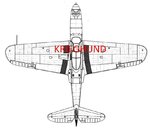Okay, think I get NACA's idea now
An issue of how would anyone succeed to mount intercooler there, is a new ball game.
While 2 cannons 4 HMGs as a SE fighter armament do sound like a good idea, the proposal has some shortcomings IMO. Ammo count, for example - we can stick to, say 100-120 shells or 250-300 HMG rounds per barrel. That way our SE fighter lugs around about same armament ammo weight as P-38, P-47, Typhoon, Tempest. Nice if one has at least 2000 HP on board, not that nice if there is only 1200 HP. Or, we can reduce the ammo count to save weight - US pilots would've hated us, and the weight of armament is still there.
We can delete a pair of HMGs, and the armament ammo weight is like at P-51D, Hellcat, Corsair - but our plane still lacks 300-400 HP if we want it to be competitive.
There are other minor things to consider, like need to purchase another 10000 cannons from UK, 3 guns (= cannon + 2 guns) are easier to install maintain than 6, less drag (3 openings less), single gun heater can heat all armament, almost no impact to accuracy if one gun jams, central battery is not susceptible to wing flex, less inertia - better roll...
My proposal cuts weight (P-39 was able to out-climb any contemporary US single-engined fighter anyway), while enabling all 3 guns to be fired simultaneously (similar bullet paths).
I think 5 x .50 cal in the nose would be sufficient.




